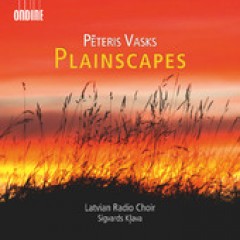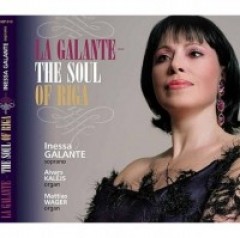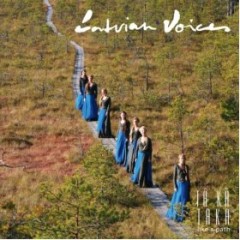
Though Latvian composer Pēteris Vasks has achieved success and fame with compositions for solo instruments, string quartets, orchestras, piano, among many other instruments, some of his most powerful and memorable works are his choir songs. The addition of text and language (particularly the Latvian language), in combination with the exceptional skill of the world-class Latvian Radio Choir, make his choir songs particularly haunting and emotionally affecting.
This is clearly evidenced on Plainscapes, a 2012 release by Finnish label Ondine, featuring the Latvian Radio choir performing a number of Vasks’ secular choir works, conducted by Sigvards Kļava – an album that is, in my opinion, destined to be one of the best and most significant Latvian classical music releases of 2012.
The Latvian Radio Choir, an ensemble that distinguishes itself by its focus on modern repertoire – both Latvian and international – is well familiar with the works of Vasks. In fact, Plainscapes could be considered a spiritual continuation of the work they already recorded on Māte saule (BIS records, BIS-CD-1145, released in 2000), also predominantly secular compositions. Vasks has worked closely with the Radio Choir throughout the years, and having direct access to the composer himself gives the choir unique insight into the composer’s precise vision when realizing these works.
Though Vasks’ choir work “Zīles ziņa” (The Tomtit’s Message) was composed in 1981 (with lyrics by Uldis Bērziņš), originally for women’s choirs, it has enjoyed a notable rise in popularity over the past few years. A number of choirs have performed the work – one can hear the youth choir Kamēr… interpretation of it on their 2007 CD Veltījumi, as well as the mixed choir Sōla providing their interpretation on their 2008 CD Pūra dziesmas. Broadly, the song is about the apprehension over one’s brother going to war and the fact that he will most likely not return. As with many Vasks songs, it has an ominous feeling about it – a quiet beginning, a driving, almost galloping middle section (perhaps appropriate, as the lyrics at that moment are about the brother riding his horse), leading to the intentionally exaggerated howls of laughter of the warlord. The song finishes with a quietly rising tension as the choir sings ‘paiet gadu daudz’ (many years pass). This tour de force by both composer and choir makes this work and performance one of the most memorable Vasks choir interpretations.
The longest work on the album, “Līdzenuma ainavas” (Plainscapes) features Sandis Šteinbergs on violin and Guna Āboltiņa on cello, providing accompaniment while the choir vocalizes (the song has no lyrics). Though more than sixteen minutes, the performance is never dull as the choir interplays with the instruments, providing the listener with an imaginative wander through the plains and fields of Zemgale.
Of course, Vasks is not always gloom and doom. Vasks, directly and indirectly, ensures that there is something of Latvia in his compositions – he makes it clear that he is truly a Latvian composer. For example in the very brief work “Mazi, silti svētki” (A Moment of Celebration) composed for women’s choirs with lyrics by Jānis Baltvilks, there is a positive view on Latvia, that “Gabaliņš Latvijas ir atkal sakopts” (A piece of Latvia is tidied up again), making this a particularly personal, not to mention hopeful, composition.
Originally performed by Kamēr… on their World Sun Songs collection, “Piedzimšana” (Birth), lyrics by Inese Zandere, closes off the album. It is another longer performance, at more than twelve minutes, and the poetry of Zandere is almost in a Latvian folk song style, as it evokes images of the sun as the giver of life and soul, as a sort of goddess of Latvian folklore.
The CD booklet also contains a lengthy, insightful interview in English with the composer by Ināra Jakubone of the Latvian Music Information Centre, revealing a number of interesting details about the compositions, particularly about the song “Mūsu māšu vārdi” (Our Mothers’ Names), lyrics by Māris Čaklais, discussing why the poet gives the mothers the names of birds.
Perhaps it is no surprise that when you combine one of the best Latvian choirs (if not world choirs) with one of the best Latvian composers you get an exceptional result. Under the direction of conductor Sigvards Kļava, the Latvian Radio Choir has once again proven that they, unquestionably, belong among the ranks of the best choirs in the world. Due to their unique and singular access and collaboration with the composer himself, they are in a position to truly present the works as Vasks intended them to be heard. As a result, Plainscapes, beyond being a testament to the abilities of the choir and the compositional talent of Vasks, is one of the most significant, not to mention enjoyable and emotionally affecting, choir recordings in recent memory.
Details
Plainscapes
Pēteris Vasks
Finland: Ondine, 2012
ODE 1194-2
Track listing:
1. The Message of the Titmouse(Zīles ziņa, 1981/2004)
2. Silent Songs (Klusās dziesmas, 1979/1992) I. Nosāpi pārsāpi
3. II. Dusi dusi
4. III. Trīs meži
5. IV. Paldies tev vēlā saule
6. Our Mothers’ Names (Mūsu māšu vārdi, 1977/2003)
7. The Sad Mother (Skumjā māte, 1980/91)
8. Summer (Vasara, 1978)
9. Plainscapes (Līdzenuma ainavas, 2002)
10. A Moment of Celebration (Mazi, silti svētki, 1988)
11. Birth (Piedzimšana, 2008)
Where to buy
Purchase Plainscapes from Amazon.com.
Note: Latvians Online receives a commission on purchases.





